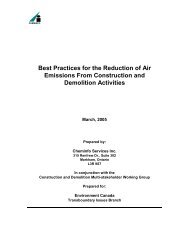Burrard Inlet Environmental Indicators Report - the BIEAP and ...
Burrard Inlet Environmental Indicators Report - the BIEAP and ...
Burrard Inlet Environmental Indicators Report - the BIEAP and ...
Create successful ePaper yourself
Turn your PDF publications into a flip-book with our unique Google optimized e-Paper software.
<strong>Burrard</strong> <strong>Inlet</strong> <strong>Environmental</strong> <strong>Indicators</strong> <strong>Report</strong> February 2008<br />
Results <strong>and</strong> Trends<br />
Copper <strong>and</strong> PCB levels are <strong>the</strong> selected<br />
indicators; however, many o<strong>the</strong>r contaminants<br />
also enter <strong>Burrard</strong> <strong>Inlet</strong>, where <strong>the</strong>y may have a<br />
negative effect on marine life. Water <strong>and</strong><br />
sediment are also monitored for pH (acidity or<br />
alkalinity), dissolved oxygen, suspended solids,<br />
turbidity, o<strong>the</strong>r metals (arsenic, cadmium,<br />
chromium, lead, mercury, nickel <strong>and</strong> zinc)<br />
bacteria (total coliforms, enterococci), chlorineproduced<br />
oxidants, cyanide, ammonia,<br />
hydrogen sulphide, phenol, chlorophenol,<br />
styrene, tributyl tin, 1,2-dichloroethane <strong>and</strong><br />
polycyclic aromatic hydrocarbons (PAHs).<br />
Copper concentrations in water<br />
Between 1985 <strong>and</strong> 2005, 86 samples were<br />
collected from several sites in <strong>Burrard</strong> <strong>Inlet</strong>.<br />
Copper levels ranged from 0.0001 mg/L to 0.012<br />
mg/L, with 17 samples (20%) exceeding <strong>the</strong> water<br />
quality guideline maximum of 0.003 mg/L. Data<br />
were examined for change over time, but no<br />
statistically significant trends were apparent.<br />
Samples from <strong>the</strong> Central Harbour had <strong>the</strong> lowest<br />
number of exceedances. These results highlight<br />
<strong>the</strong> difficulties associated with sampling water,<br />
which can easily miss transient events. In such<br />
cases, copper levels in sediment can provide<br />
more reliable indications of changes over time.<br />
Copper concentration in sediment (mg/kg)<br />
Copper in <strong>the</strong> surface microlayer<br />
The surface microlalyer, <strong>the</strong> 50 to 100 micron<br />
thin boundary between water <strong>and</strong> air is<br />
ecologically important. This is <strong>the</strong> area where<br />
complex transport processes occur between<br />
<strong>the</strong> ocean <strong>and</strong> atmosphere <strong>and</strong> where larval<br />
forms of many fish <strong>and</strong> invertebrates live. The<br />
surface microlayer has been shown to contain<br />
contaminants at levels many times higher than<br />
in <strong>the</strong> water column, which may have an<br />
impact on marine life stages that inhabit this<br />
layer.<br />
In 2000, <strong>the</strong> Ministry of Environment collected<br />
surface microlayer samples at six locations in<br />
<strong>Burrard</strong> <strong>Inlet</strong> (Moore <strong>and</strong> Freyman 2001).<br />
Copper levels exceeded water quality<br />
guidelines, <strong>and</strong> were 3 to 30 times higher than<br />
in <strong>the</strong> underlying water. Levels were greatest<br />
in <strong>the</strong> Inner Harbour <strong>and</strong> Port Moody Arm. This<br />
suggests contamination in areas immediately<br />
surrounding point sources, or in embayed<br />
areas adjacent to developed l<strong>and</strong>s, which can<br />
supply atmospheric deposition <strong>and</strong> runoff.<br />
Based on this limited sampling, it is not<br />
expected that significant microlayer<br />
contamination extends over large areas of<br />
Georgia Strait; however, fur<strong>the</strong>r monitoring is<br />
required to characterize <strong>the</strong> environmental<br />
significance of microlayer contamination.<br />
Chart 6-1: Copper Concentrations in <strong>Burrard</strong> <strong>Inlet</strong> Sediment (1985 to 2005)<br />
400<br />
350<br />
Central Harbour<br />
False Creek East<br />
Inner Harbour<br />
Copper concentrations in<br />
sediment have decreased<br />
consistently between 1989 <strong>and</strong><br />
300<br />
250<br />
Outer Harbour North<br />
Outer Harbour South<br />
Port Moody Arm<br />
Sediment quality objective<br />
2005 as shown in Chart 6-1,<br />
although levels still exceed<br />
guidelines (108 mg/kg, probable<br />
200<br />
effects level) at <strong>the</strong> Outer Harbour<br />
North <strong>and</strong> Inner Harbour locations.<br />
150<br />
Levels higher than this guideline<br />
100<br />
put sediment-dwelling organisms<br />
at risk for toxic effects. Historically,<br />
50<br />
levels were highest within <strong>the</strong><br />
0<br />
1984 1986 1988 1990 1992 1994 1996 1998 2000 2002 2004 2006<br />
Inner Harbour <strong>and</strong> lowest in Outer<br />
Harbour South. The amount of<br />
copper in surface sediments is<br />
decreasing, in part due to decreased levels from permitted effluents, combined sewer overflows<br />
<strong>and</strong> industrial sources <strong>and</strong> in part because Metro Vancouver has added buffering to <strong>the</strong> drinking<br />
water (less acidic drinking water results in less leaching of copper from older household pipes).<br />
Page | 32
















